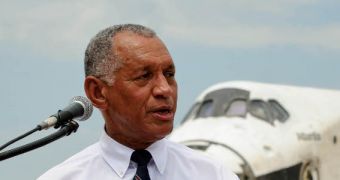On Tuesday, March 4, NASA Administrator Charles Bolden released a statement covering the space agency's budget for fiscal year (FY) 2015. At $17.5 billion (€12.6 billion), funds are insufficient to undertake any significant new projects, so NASA will this year work under a maintenance regime.
The entire budget of the United States for FY2015 is estimated at $3.9 trillion (€2.82 trillion), so NASA is getting just a very small piece of the cake. However, this level of funding should prove sufficient to maintain most of the agency's ongoing projects, and it may very well suffice to promote some advancements in proposals related to exploring Mars and Jupiter's moon Europa.
However, some astronomy programs, as well as a number of climate-monitoring projects, will be scaled back. It is entirely possible that even the NASA/DLR Stratospheric Observatory for Infrared Astronomy (SOFIA) airborne telescope will be grounded for the remainder of the year.
This year's budget is around $100 million (€72.2 million) below that of FY 2014, but it was maintained in line with the Bipartisan Budget Act of 2013 (BBA), a compromise between Democrats and Republicans to avoid even deeper cuts across the board.
NASA could theoretically opt to access a portion of the $56-billion (€40.4-billion) Opportunity, Growth, and Security Initiative (OGSI), a plan that will come into effect if Congress authorizes extra expenditures for this year. The space agency could stand to access another $886 million (€640 million), IEEE Spectrum reports.
Fortunately, even the basic budget comes with provisions of continued support for flagship missions, such as the James Web Space Telescope. The FY2015 NASA budget allots $645 million (€465.6 million) for this project. Another $3.05 billion (€2.2 billion) will go towards continuing support for the International Space Station until at least 2024, in accordance with decisions taken earlier this year.
Between themselves, the Space Launch System (SLS) and Orion Multipurpose Crew Vehicle (MPCV) projects will get $2.78 billion (€2 billion). The two spacecraft are scheduled to fly together for the first time in late 2017 or early 2018. The first test flight for Orion is scheduled for this September.
Some of the missions that will lose a lot this year, or that will be mothballed completely, include SOFIA, the Orbiting Carbon Observatory (OCO-3), and the Pre-Aerosol, Clouds and Ocean Ecosystem (PACE) satellite. Under the FY2015 budget, the SOFIA project loses no less than $85 million (€61.3 million).
If the OGSI option enters effect, then NASA may become able to support other missions and projects as well, including the $94-million (€68-million) Measurement Science Laboratory planned to be built at the Langley Research Center, in Virginia. Additionally, the development of the SLS and the Orion could be accelerated via a $451-million (€325.5-million) influx into these projects.

 14 DAY TRIAL //
14 DAY TRIAL //